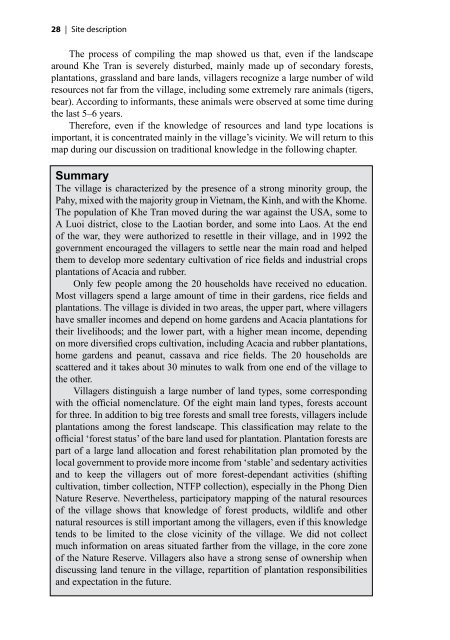English 2.28MB - Center for International Forestry Research
English 2.28MB - Center for International Forestry Research
English 2.28MB - Center for International Forestry Research
You also want an ePaper? Increase the reach of your titles
YUMPU automatically turns print PDFs into web optimized ePapers that Google loves.
| Site description<br />
The process of compiling the map showed us that, even if the landscape<br />
around Khe Tran is severely disturbed, mainly made up of secondary <strong>for</strong>ests,<br />
plantations, grassland and bare lands, villagers recognize a large number of wild<br />
resources not far from the village, including some extremely rare animals (tigers,<br />
bear). According to in<strong>for</strong>mants, these animals were observed at some time during<br />
the last 5–6 years.<br />
There<strong>for</strong>e, even if the knowledge of resources and land type locations is<br />
important, it is concentrated mainly in the village’s vicinity. We will return to this<br />
map during our discussion on traditional knowledge in the following chapter.<br />
Summary<br />
The village is characterized by the presence of a strong minority group, the<br />
Pahy, mixed with the majority group in Vietnam, the Kinh, and with the Khome.<br />
The population of Khe Tran moved during the war against the USA, some to<br />
A Luoi district, close to the Laotian border, and some into Laos. At the end<br />
of the war, they were authorized to resettle in their village, and in 1992 the<br />
government encouraged the villagers to settle near the main road and helped<br />
them to develop more sedentary cultivation of rice fields and industrial crops<br />
plantations of Acacia and rubber.<br />
Only few people among the 20 households have received no education.<br />
Most villagers spend a large amount of time in their gardens, rice fields and<br />
plantations. The village is divided in two areas, the upper part, where villagers<br />
have smaller incomes and depend on home gardens and Acacia plantations <strong>for</strong><br />
their livelihoods; and the lower part, with a higher mean income, depending<br />
on more diversified crops cultivation, including Acacia and rubber plantations,<br />
home gardens and peanut, cassava and rice fields. The 20 households are<br />
scattered and it takes about 30 minutes to walk from one end of the village to<br />
the other.<br />
Villagers distinguish a large number of land types, some corresponding<br />
with the official nomenclature. Of the eight main land types, <strong>for</strong>ests account<br />
<strong>for</strong> three. In addition to big tree <strong>for</strong>ests and small tree <strong>for</strong>ests, villagers include<br />
plantations among the <strong>for</strong>est landscape. This classification may relate to the<br />
official ‘<strong>for</strong>est status’ of the bare land used <strong>for</strong> plantation. Plantation <strong>for</strong>ests are<br />
part of a large land allocation and <strong>for</strong>est rehabilitation plan promoted by the<br />
local government to provide more income from ‘stable’ and sedentary activities<br />
and to keep the villagers out of more <strong>for</strong>est-dependant activities (shifting<br />
cultivation, timber collection, NTFP collection), especially in the Phong Dien<br />
Nature Reserve. Nevertheless, participatory mapping of the natural resources<br />
of the village shows that knowledge of <strong>for</strong>est products, wildlife and other<br />
natural resources is still important among the villagers, even if this knowledge<br />
tends to be limited to the close vicinity of the village. We did not collect<br />
much in<strong>for</strong>mation on areas situated farther from the village, in the core zone<br />
of the Nature Reserve. Villagers also have a strong sense of ownership when<br />
discussing land tenure in the village, repartition of plantation responsibilities<br />
and expectation in the future.

















